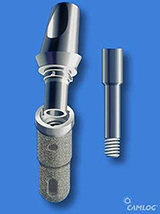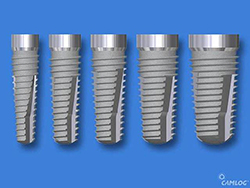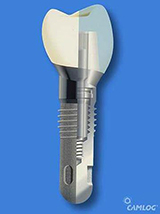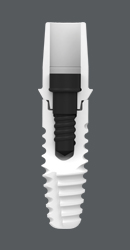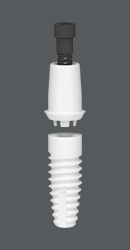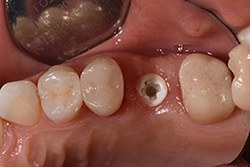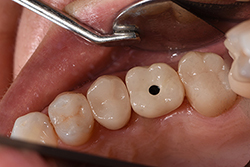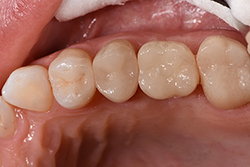Hardly any other area of dental medicine has progressed as rapidly in recent years as implantology. While healthy teeth used to be ground down to act as supports for bridges or even removed completely to make way for prostheses that didn't always fit as well as they should, these days patients can be fitted with comfortable, attractive-looking substitutes in almost every situation.
Procedure:
The basic elements of the procedure have been familiar for more than 40 years and are very reliable: a hole is drilled in the gap left by the missing tooth and the implant inserted or screwed in like a dowel. The surrounding bone quickly grows to enclose the implant so completely that it will actually sit more firmly than a natural tooth root. This healing phase lasts for several months, during which time the new tooth root is hidden under the gum. Once the healing period is over, the gum is reopened microsurgically under anaesthetic to obtain access to the implant. The dentist and dental technician can now work together to manufacture and insert the new teeth.
Indications:
There are various factors that may indicate implantation; in most cases, the procedure is performed to replace a missing tooth. The insertion of a single tooth protects the neighbouring teeth. Often one last tooth required for the construction of a dental substitute may be lost due to gum disease, which means the conventional technique of constructing a bridge can no longer be used. In earlier times, this invariably led to the patient being fitted with some kind of prosthesis: these days, the missing posterior teeth can be replaced by implants.
Even today, implants are still used for their original purpose, i.e. to stabilize prostheses in patients who have no teeth. In cases of extreme bone loss, it may be impossible to provide fixed tooth replacements. In such cases, removable dentures have to be made for the patient on cosmetic grounds. However, these sit just as firmly as fixed, cemented constructions and provide the wearer with maximum chewing comfort and a natural appearance.
If there is too little bone or gum tissue to insert implants, dentists now have various options available for replacing and rebuilding missing substances with the aid of microsurgical implants or bone substitute which does not necessarily have to be taken from the patient himself.
Contraindications:
These procedures can even be performed on elderly patients, as the body retains its capacity to heal bone all its life. Age-related osteoporosis of the spine does not usually have any negative effect on jaw healing. However, this form of treatment is contraindicated in patients with poorly controlled diabetes, severe heart disease, uncontrollable blood coagulation diseases or who are undergoing treatment with growth-inhibiting medication. This is why the patient’s physical condition must be checked by an internal specialist before any implantological treatment is given.
Anaesthetic:
In general, implantological treatments can also be administered under local anaesthetic. However, as the treatment lasts some time, we offer sedation – especially for nervous patients – using a narcotic. For this kind of pain control, the patient is put into a light sleep using the drug Dormicum. An anaesthetist may also be helpful if extensive treatment has to be given; he can then give a general anaesthetic so that the patient is completely unaware of what is going on, according to the motto “We work, you sleep”.
Parking
Multi-storey car park
We offer parking places on the other side of the street next to the Kurpark.
Multi-storey car park
There is a multi-storey car park 100m away next to Königkarlstrasse 1 that you can use.
More details here Journey.


